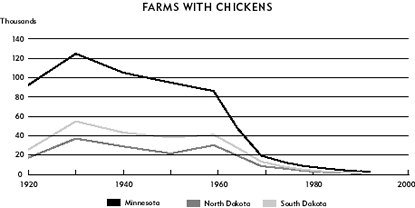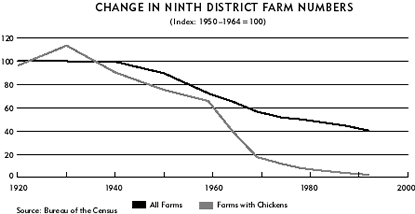The United States cannot take all the credit for the dramatic improvements in efficiency in poultry production over the last 50 years. Indeed, a substantial portion of the research and technology development that led to industrialized poultry production took place in Europe, just as it did for intensive hog and milk production.
But the bulk of the innovation was American, and U.S. technology and U.S. firms have been important in the spread of intensive poultry technology to other countries, including relatively poor countries of Latin America and Asia. In those regions, chicken and turkey meat have made large contributions to improving the diets of large segments of the population. In some cases, rising demand was first met by U.S. exports of poultry products, which were then supplanted by local production as new technology took hold.
Such adoption of technology did not hurt the U.S. farm sector as a whole. Development of the poultry industry in other countries has created a major export market for U.S. corn and soybeans, the most important components of poultry rations, as well as for breeding stock and equipment.
In spite of increased production in many countries, U.S. exports of poultry products have continued to grow over the last 20 years. From 1975 to 1985, all U.S. agricultural exports grew by 50 percent, while poultry exports tripled. And from 1985 to 1995, all ag exports grew by another 80 percent, while poultry exports more than quintupled.
U.S.-style chicken production spread to Latin America in the late 1970s. On Peru's arid coast, broilers are produced with minimal facilities given the lack of rainfall and near-constant year-round temperature. Most of the inputs are imported. "We don't produce broilers, we assemble them," says Peruvian animal scientist Arturo Carrasco, referring to his nation's imports of feeders, waterers, corn and even fertilized eggs for its broiler producers.
In Brazil, where output of poultry meat increased three times over between 1980 and 1995, production is concentrated in the southern states of Parana and São Paulo. As in the United States, most growers contract with feed producers or processors. Brazil, with two of the world's largest and most modern producers, is a major U.S. competitor in the sale of broilers and broiler parts, particularly legs and wings, in Eastern Europe, especially Russia, and in Asia. If the proposed Free Trade Area of the Americas discussed in Santiago, Chile, in April 1998, ever becomes a fact, U.S. poultry producers will probably face competition in their domestic market from counterparts in Latin America.
In Asia, broiler production increased with incomes, especially in Taiwan, Korea, Thailand and Indonesia. In Taiwan, production doubled in the decade from 1985 to 1995, while in Thailand there was a 21 percent increase in the two years from 1993 to 1995. All depended to some extent on feed or other inputs imported from the United States. In the same decade in which Taiwan doubled poultry meat production, it also doubled imports of corn from the United States from 3 million to 6 million metric tons.
These markets have been upset by the ongoing financial crises in this region, but the long-run outlook is generally favorable. The effect of rising incomes on diets and meat consumption is especially important in China. Again, long-term growth of poultry production in China depends to a large extent on difficult structural changes in the economy as a whole. But as Chinese incomes have risen in the two decades since Deng Xiaoping initiated reforms in 1978, chicken consumption has risen dramatically. China is largely self-sufficient in feed production, but increasing meat production is taking larger and larger shares of grain output. Over time, if economic reform and growth continue in China, U.S. exports are likely to grow. Even the marginal swings in the Chinese import/export balance can have major effects on world, and Ninth District, grain prices.
The European Union produces most of its own poultry. But European poultry production has accounted for a substantial proportion of world soybean meal usage for three decades and will continue to do so. The United States has exported some chicken to Europe over the years. Indeed, the 1960s trade dispute between the United States and Germany that was dubbed "the chicken war" is well known to students of international trade and of international law.
Recent or prospective entrants to the European Union such as the Czech Republic, Hungary and Bulgaria have resource endowments that are favorable to broiler and egg production, so U.S. agriculture should not necessarily look to the European Union as a growth market. But as the world's most efficient producers of corn and soybeans, Ninth District farmers should gain some benefit from increased poultry production nearly anywhere in the world.







